April 21, 2006
Air Date: April 21, 2006
FULL SHOW
SEGMENTS
EU on Atrazine
View the page for this story
The European Union has banned one of the worlds most widely used pesticides. Atrazine in drinking water has been linked to prostate and breast cancer. Host Steve Curwood talks with Professor Tyrone Hayes of UC Berkeley about his research on the chemical's prevalence in the United States. (06:45)
Chernobyl at 20
/ Bruce GellermanView the page for this story
Twenty years ago this week one of the reactors at the Chernobyl Nuclear Power Plant in Ukraine exploded. Radiation from the disaster spread over the entire Northern Hemisphere. Bruce Gellerman investigates the scientific controversy over the health effects of the worst nuclear accident in history. (05:00)
Shinin' on Through
View the page for this story
Recent research shows that the amount of sunlight getting through the Earth’s atmosphere has dropped since 1945. But as our skies got cleaner during the 90's, sunlight levels bounced back. Martin Wild of the Institute for Atmospheric and Climate Science in Zurich, Switzerland tells host Steve Curwood why this phenomenon may speed the warming of the planet due to climate change. (06:40)
Global Warming for Ages 10 and Up
/ Chelsea RosenthalView the page for this story
Andrew Revkin, science reporter for the New York Times, has a new book out about global warming. It's called “The North Pole Was Here” and it's geared for young readers. Chelsea Rosenthal a senior at South Portland High school reviews Revkin's new book. (06:40)
Listening to Alaska
/ Amy MayerView the page for this story
In an empty white room in a museum in Fairbanks, composer John Luther Adams has created a soundscape of geological and environmental scenes of Alaska. Amy Mayer reports. (06:00)
Note on Emerging Science
/ Bobby BascombView the page for this story
Chemicals used in the making of flame retardant materials have been linked to obesity and type II diabetes in rats. Bobby Bascomb reports. (01:30)
Early Signs: Bangladesh
/ Sandhya Somashekhar and Emilie RagusoView the page for this story
When scientists discuss countries at risk from the potential effects of climate change, they point to Bangladesh. Just above sea level, and in the flood plain of the Ganges and Brahmaputra rivers, 144 million people live in a space the size of Wisconsin. Producers Sandhya Somashekhar and Emilie Raguso report on what’s at stake for Bangladesh. (15:45)
This week's EarthEar selection
listen /
download
Sacred Sounds of India. Recorded by Hildegard Westerkamp.
Show Credits and Funders
Show Transcript
HOST: Steve Curwood
GUESTS: Prof. Tyrone Hayes, Dr. Martin Wild
REPORTERS: Bruce Gellerman, Amy Mayer, Sandhya Somashekhar, Emilie Raguso
COMMENTARY: Chelsea Rosenthal
NOTE: Bobby Bascomb
[THEME MUSIC]
CURWOOD: From NPR, this is Living on Earth.
[THEME MUSIC]
CURWOOD: I’m Steve Curwood. The heavily used pesticide Atrazine has been associated with prostate and breast cancers, and now the EU has banned it in Europe. But regulators in the US say they won’t follow suit, and some critics say that’s a big mistake.
HAYES: Essentially in the United States we’ve put a price on our breasts, on our prostate, on our environmental health, and decided that the economic hit to banning Atrazine, that concern exceeds our concern for environmental health and public health.
CURWOOD: Also, two decades after the worst nuclear power accident in history scientists still can’t agree on the legacy of Chernobyl.
METTLER: What we said in the report, in that particular section on mortality, was the exact number of deaths due to this accident will probably never be known.
CURWOOD: Chernobyl plus twenty and why it matters today. That and more, this week on Living on Earth. Stick around.
[NPR NEWSCAST]
ANNOUNCER: Support for Living on Earth comes from the National Science Foundation, Stonyfield Farm, and Kashi, makers of crackers, granola bars and cereal, made from seven whole grains. Learn more at Kashi.com
[THEME MUSIC]
EU on Atrazine
CURWOOD: From the Jennifer and Ted Stanley studios in Somerville, Massachusetts, this is Living on Earth. I’m Steve Curwood.
The European Union has banned the herbicide Atrazine, effective next year, after finding it contaminated a number of drinking water supplies. The weed killer first came under scrutiny for its effects on frogs, and more recently has been linked to adverse affects on human health.
Some 70 million pounds of Atrazine are used in the U.S. each year, mostly on cornfields. After studying Atrazine, the Environmental Protection Agency decided not to ban it in the U.S., but says its research into the chemical continues.
Joining me now is Tyrone Hayes, a professor at UC Berkeley who’s done pivotal research on Atrazine. And he’s just back from Europe, we caught up with him at the airport. Professor Hayes, welcome to Living on Earth.
HAYES: Good to be here.
CURWOOD: So from your expertise, what’s your analysis of the science behind the EU’s decision to ban Atrazine?
HAYES: Well, there’s a great deal of data showing Atrazine is in fact an endocrine disrupter. In amphibians, Atrazine results in the demasculinization – chemical castration – of male frogs, and subsequent feminization. It produces hermaphroditic frogs, males with ovaries and eggs. And in rodents and humans Atrazine is associated with breast cancer and prostate cancer and low sperm count.
The European Union has a slightly different approach to regulating chemicals than the United States. It operates under the precautionary principle, which says that if there is the potential for a chemical to cause environmental and public health harm, then that chemical is regulated. And in the case of Atrazine, banned, because it’s found in the water.
The United States counts on the industry that produces the chemical to produce data to actually prove that the chemical’s harmful. There are states that have made some movements towards regulating Atrazine. For example, Wisconsin bans Atrazine county by county, depending on when it shows up in the water.
CURWOOD: Now, what about the exposures here in the real world. How much Atrazine has been found in U.S. drinking water? And how does that compare to what’s been found in Europe?
HAYES: I think the levels are about equal between the United States and Europe. The current drinking water standard in the United States is three parts per billion, and, particularly in the Midwest, that three parts per billion can be exceeded. But, in fact, we know now that Atrazine is biologically active as low as .1 parts billion. So that’s 30 times lower than the current drinking water standard in the United States.
CURWOOD: There’s a lot of concern about prostate cancer and breast cancer here. What relationship, if any, is there between Atrazine and those diseases?
HAYES: The relationship between Atrazine and prostate cancer and breast cancer is very significant. Experimental evidence in rodents show that Atrazine is associated with an increased incident of both prostate cancer and breast cancer. And correlational evidence in humans shows that people who are exposed to Atrazine have higher rates of breast cancer and prostate cancer.
In fact, if you feed a female rat Atrazine – her pups that she is suckling, her male pups, can develop prostate disease. So those effects of Atrazine are transferable even from the mother to the suckling pup.
There’s also studies showing that prostate cancer was increased in men who worked in a factory that produced Atrazine. The levels of prostate disease and prostate cancer were 8.4-fold higher than expected, and 8.4-fold higher than men who worked in the factory but were not exposed to Atrazine.
So given that Atrazine is the number one selling pesticide in the world, and given that breast cancer and prostate cancer are the number one cancers in men and women, respectively, then I think this is a big concern.
CURWOOD: How prevalent is the presence of Atrazine in U.S. drinking water supplies? Is this a problem for five percent of the country? Ten? Twenty? Fifty percent?
HAYES: You know, the bigger problems for Atrazine are in the Midwest, where it’s used mostly, so like Nebraska and Iowa, Indiana. The concerns are not just for people who live in areas where Atrazine is used. But people have to also understand that Atrazine travels quite far and can be found in areas that are even considered pristine. Both in Europe and the United States it’s been shown that Atrazine can be found as much as 600 miles from where it has been applied.
CURWOOD: So in your view is there enough evidence out there to ban Atrazine in the United States?
HAYES: Certainly, when you look at the environmental health risks and the public health risks and the prevalence of Atrazine in groundwater and drinking water, there’s cause for concern. When you consider on top of that the evidence in every animal class that’s been examined that Atrazine causes adverse biological effects, then this raises concern. Essentially, in the United States, we’ve put a price on our breasts, on our prostates, on our environmental health, and decided that the economic hit to banning Atrazine, that that concern exceeds our concern for environmental health and public health.
CURWOOD: Tyrone Hayes is a professor at the University of California at Berkeley. Thank you so much for speaking with me.
HAYES: My pleasure.
Related link:
Professor Tyrone Hayes Faculty Profile
[MUSIC: Mai Shi “Remarkably Dirty Animals” from ‘Sur La Mer Sampler’ (Sur La Mer - 2006)]
Chernobyl at 20
CURWOOD: It was 20 years ago on April 26th that Unit 4 at the Chernobyl Nuclear Power Plant in Ukraine erupted like a radioactive volcano. It was, and still is, the worst nuclear accident in history. Chernobyl's nuclear core burned for 10 days, sending tens of tons of radioactive particles into the air. The radiation spread across the entire Northern Hemisphere, including the United States. Studies over the last two decades have been inconclusive about the disaster's human and environmental costs. But two just-released reports predict that the loss of human life could be much higher than many previously thought. Living on Earth’s Bruce Gellerman has the details.
[ROAD SOUNDS]
GELLERMAN: A decade ago, on the tenth anniversary of the disaster, I traveled to Chernobyl.
[READING OF GEIGER COUNTER]
GELLERMAN: A Geiger counter is standard equipment in the 18-mile exclusion zone around the doomed reactor. One hundred thirty-five thousand people were evacuated from the area. People aren't supposed to live here. The rolling hills and forests are now, and perhaps forever, radioactive.
The hottest place is ground zero. A 300,000-ton concrete and steel sarcophagus entombs the unit 4 reactor. Still it leaks radiation. The Geiger counter jumps.
[RUSSIAN...4. 5 MILLIREMS....RUSSIAN]
GELLERMAN: After just a minute my guide Sasha wanted to leave.
SASHA: Machina. Better to the car.
GELLERMAN: Why is that?
SASHA: Because it's rather high. The regulation is like this 5 rem is the limit. 5 rem is the limit and you're out.
GELLERMAN: You've been working here how many years?
SASHA: Three.
GELLERMAN: How many rem do you have?
SASHA: I don't know. And I’m not interested in it.
GELLERMAN: Why aren’t you interested in learning how much?
SASHA: Because it is easier to live.
GELLERMAN: Scientists generally agree that 31 workers and firemen died immediately after the reactor exploded, and nine children have since died from thyroid cancer. But that's basically where the agreement ends. Measuring the effects of Chernobyl is an intense scientific and political controversy.
The largest study was conducted by eight UN agencies, including the IAEA, the International Atomic Energy Agency, and World Health Organization. The results were released last year.
Dr. Michael Repacholi, manager of the WHO’s radiation program, says the study sends a reassuring message:
REPACHOLI: Well, I think that it tells people what the numbers really are. That there’s no speculation in that. There’s some uncertainty in the values, but it’s very close around the 4,000 mark for cancer deaths, and the other speculations are just not valid.
GELLERMAN: But now another just-released study by UN scientists in France, says the number of Chernobyl cancer deaths could be nine times that many. Some nuclear power critics charge, this is what they've been saying all along.
HARMS: This is really a scandal.
GELLERMAN: Rebecca Harms is the Green Party's representative to the European parliament. She cites another study, called The Other Chernobyl Report, it predicts 30 to 60 thousand people will die from Chernobyl cancers, not 4,000, as the UN estimates. The difference is that the IAEA only looked at the 600,000 so-called liquidators; those who cleaned up the disaster and had the highest radiation exposures. Rebecca Harm says the green study included all of Europe.
HARMS: For health and environment, we can show that all figures which have been published by the IAEA are wrong and misguiding.
GELLERMAN: So you’re suggesting – more than suggesting – you’re saying that the IAEA has deliberately downplayed the health effects of Chernobyl?
HARMS: Yes, yes, yes.
GELLERMAN: Researchers acknowledge predicting Chernobyl cancer deaths is an uncertain science. Dr. Fred Mettler was chairman of the science panel that prepared the UN report on Chernobyl’s health effects.
METTLER: What we said in the report, on that particular section on mortality, was the exact number of deaths due to this accident will probably never be known.
On average a quarter of the population dies from cancer . So, a few thousand, even a few tens of thousand, extra deaths is difficult to measure. Especially when exposure levels are low:
METTLER: What effect would smoking, you know, in Boston have on killing people in Europe? I mean, if one wants to make those calculations, nobody can stop you from making them, but the dose levels are certainly well below anything anybody has seen cancer increases at.
GELLERMAN: Scientists aren't only looking at cancer. New studies indicate a rise in cataracts and perhaps heart disease among people exposed at levels previously considered too low to have an effect. To understand the long-term impact of radiation Chernobyl researchers have had to turn to Japan.
Chernobyl produced 250 times as much radiation as was created by the atomic bombs dropped on Hiroshima and Nagasaki combined. Dr. Fred Mettler:
METTLER: All I can say is, two to three generations out after dropping atomic bombs on a pretty large population, there is no evidence there of increased genetic damage.
GELLERMAN: Likewise, the UN study found no evidence of genetic damage due to Chernobyl, but the intense burst of radiation from a bomb isn't the same as long term, low level exposure. A lot less is known about that. And according to Dr. Tim Mousseau, a biologist from the University of South Carolina, there is evidence of genetic effects from Chernobyl, at least in some birds. Mousseau has studied barn swallows around Chernobyl for six years – 18 generations.
MOUSSEAU: We found mutations at the level of sperm morphology, sperm swimming behavior, as well as visible mutations on the bodies of these birds, including what we call partial albinos, where parts of the birds’ bodies are completely white. And this is linked to mutations in the populations of barn swallows that live in the most contaminated areas.
GELLERMAN: And Mousseau says genetic damage from Chernobyl dramatically decreased the barn swallows reproduction rate. But birds aren't people, and susceptibility to radiation varies from species to species, even from individual to individual.
Yet, despite competing studies there are lessons to be drawn from Chernobyl, says Dr. Fred Mettler, who chaired the UN report. For all intents and purposes, Chernobyl was a dirty bomb, and is therefore useful in preparing for a nuclear terrorist attack:
METTLER: There’s a lot of data about cesium in the environment, and of course cesium is one of the things people think about in dirty bombs. So there’s a lot of data in this report about how cesium acts in urban environments and how it sticks to buildings and how people get it into them and how fast it comes out of them. And all that is incredible data for planning from Homeland Security purposes.
GELLERMAN: So the legacy of Chernobyl is that, what we learn from it, may one day save us...from ourselves. For Living on Earth, I’m Bruce Gellerman.
Related links:
- International site for information on Chernobyl
- The International Atomic Energy Agency on Chernobyl
- Critical analysis of a recent report by the IAEA and WHO on Chernobyl
[MUSIC Bill Madden “Dangerous Game” from ‘Gone’ (Mad Muse – 2006)]
CURWOOD: Coming up: why global warming took a holiday during the Sixties and Seventies. Stay tuned to Living on Earth.
[MUSIC: King Cobb Steelie “Skyscraper” from ‘Mayday’ (Rykodisc – 2001)]
Shinin' on Through
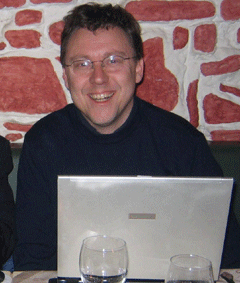
Dr. Martin Wild prepares for a climate conference in Vienna, Austria. (Dr. Martin Wild)
CURWOOD: It’s Living on Earth. I’m Steve Curwood. Summer’s coming – a time for hot cars. But I’m not talking about Ferraris or Corvettes. No, I’m talking about the kind of hot you get when the sun beats down on a parked car with the windows rolled up. A reflecting cardboard in the windshield can keep a car cool, and that fact is now telling us something about global warming.
All those aerosols and pollutants we threw into the air in the decades following World War II acted like a shade for the whole planet. Scientists even have a name for this phenomenon. They call it “Solar Dimming,” and they say it has shielded us from the full impact of global warming. But now they say the shade is disappearing.
Joining me is Dr. Martin Wild of the Institute for Atmospheric and Climate Science in Zurich, Switzerland. Hello, sir.
WILD: Hello.
CURWOOD: Dr. Wild, it seems that the amount of sunlight that gets through to Earth varies in different places around the world.
WILD: That’s true. That’s true. We found that particularly during the 60s up to the 80s there have been many parts of the globe the sunlight has become less and less. And at our institute in Switzerland we collect all the data on available sunshine at the surface, and what we see in this data is that there has been dimming of a large part of the globe. And this dimming was particularly pronounced between the 1960s and 1980s. And we believe that the growing air pollution has been an important cause of these changes because the manmade air pollution releases more and more tiny particles into the atmosphere, and these particles can then absorb or scatter back sunlight, and thereby effectively shield the surface from obtaining sunlight

Dr. Martin Wild prepares for a climate conference in Vienna, Austria. (Dr. Martin Wild)
WILD: This is due to the fact that the atmosphere has become cleaner, and therefore more transparent, over large parts of the globe during the 1990s. And contributing to this was, on the one hand, the breakdown of the former Communist countries in Russia and Eastern Europe, which resulted in less air pollution. And also air quality measures have become effective in recent years, which helps the atmosphere to become cleaner, and therefore more transparent for sunlight.
CURWOOD: Now how do you measure the amount of sunlight that gets through the atmosphere?
WILD: We have a global network of surface measurements which are set up over wide areas of the globe, and we collect this data to see how sunlight varies over time. And this data made it also possible that we could discover this phenomenon of the global dimming, which is the reduction of sunlight at the Earth’s surface, but also the more recent recovery toward brightening over many pats of the globe.
CURWOOD: How much sunlight was being lost in those decades?
WILD: At the measurements center we can observe the changes that the Earth’s surface received sunlight decreases by about two percent per decade. So this is quite a substantial amount. Now we do not see this continuation of dimming anymore except for some parts of the world which have still-increasing air pollution. One of these examples is the Indian subcontinent. There air pollution is still increasing, and this results in the so-called Asian brown clouds which resides over India, particularly in the dry season, and shields the surface from sunlight.
CURWOOD: So we’re still dimmer today than we were almost 50 years ago, but we’re brighter than we were when things were really polluted?
WILD: That’s true, that’s true, that’s true. That at least applies for the extra tropics. In the tropics in India there is still a tendency that we are now at the lowest level of sunlight which we did not reach before.
CURWOOD: Now how much has the solar dimming masked global warming?
WILD: Well solar dimming has been masking global warming very effectively after the mid-80s. Since then, when dimming disappeared and no longer compensated for the global warming, we see the full dimension of the greenhouse effect. We see this, for example, in an unparalleled temperature rise during the last two decades. As another example, we can mention the mountain glaciers which are retreating very strongly since the mid-80s while the same glaciers did not change at all during the previous decades where dimming still prevented the glaciers from melting away.
CURWOOD: Now some people listening to us might say, Oh, well maybe we should bring the pollution back to help save the Earth from global warming. What would you say to them?
WILD: Yeah, I think we should avoid playing one environmental risk off another one. So both global dimming and warming are issues which we have to take very seriously. Global dimming and its related increase in air pollution causes serious health problems, while global warming, on the other hand, puts severe stress on our ecosystems and worsens our living conditions.
I think it would be therefore disastrous to believe we can fight global warming by global dimming, and by increasing air pollution. I rather believe that in such a complex system like the global ecosystem we can not just try to remedy one problem in isolation. We have to take an integral approach to keep our planet livable. This means we have to reduce as much as possible both air pollution and the release of greenhouse gasses into the atmosphere.
CURWOOD: Switzerland is famous for its alpine skiing. How much has the effect of climate change affected your skiing industry right there in Switzerland?
WILD: I think it’s quite a big problem, so the ski season has become less extended. And also the glaciers have retreated so much everybody can see, and this is of course also, in terms of tourism, a problem because the glaciers are just not there anymore where you could see them a couple of decades before.
CURWOOD: Dr. Martin Wild is with the Institute for Atmospheric and Climate Science in Zurich, Switzerland. Thank you, sir.
WILD: It was my pleasure. Thank you.
Related link:
The Institute for Atmospheric and Climate Science in Zurich, Switzerland.
Global Warming for Ages 10 and Up
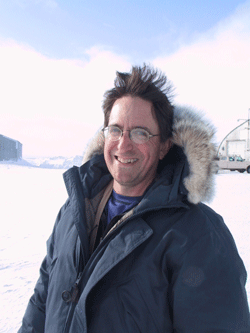
Andrew Revkin in the Arctic (Alexandra Witze)
CURWOOD: Andrew Revkin has been reporting on climate change since he started writing for the New York Times more than a decade ago. He's traveled the world breaking stories on climate research and uncovering government attempts to censor findings confirming global warming. And in his spare time, he's been hanging out in the Arctic.
Andy Revkin's new book, “The North Pole Was Here,” compiles what he's learned about global warming at the top of the world, and puts it in a form geared for readers age ten and up. We asked Chelsea Rosenthal, she’s a senior at South Portland High School in Portland, Maine, to give us a review.
ROSENTHAL: I can tell you that the symbol for Potassium on the periodic table is the letter K, that the formula for the speed of light is 3 X 10^8 meters per second, and that the mitochondrion exists in both plant and animal cells. But not one science course in all of my high school years had a unit on global warming. No lessons on climate change, or the impact it could have on our lives.
I believe the youth in America today care about the future and care about the planet, but we just don't know enough about it. That's where New York Times science reporter Andrew Revkin comes in. His new book, “The North Pole Was Here,” targets a younger group of readers. He says, "I decided to speak to the next generation…it's their world that today's adults are affecting."
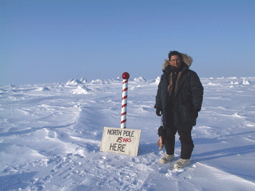
Andrew Revkin in the Arctic (Peter West/National Science Foundation)
And really, who wouldn't want to read a book that takes you to the top of the world? Revkin wrote some of the articles on the ice, with a computer covered in pocket warmers to keep the battery from freezing. And this wasn't just your standard pond ice, this was fragmented sea ice covering arctic ocean two miles deep. In his time on the North Pole Revkin saw 24 hours of straight sunlight and he even had to carry around a shotgun in case a polar bear showed up in camp. “The North Pole Was Here” is more than just a book. It's an adventure to a place few of us will ever get to see.
Revkin has been writing about global warming for years. And it's a tough message to get through to people. If everyone’s high school science class experience is like mine, this is probably because most of us don’t really understand exactly what global warming is and what it could mean.
Global warming is caused by the release of greenhouse gases into the air, which then trap in heat. For the majority of the world, the change in climate will be gradual. Revkin describes it as a thermostat, slowly being turned up – we won’t notice big changes from day to day.
But, it's a different story in the Arctic. Revkin says it would be like flipping a switch or a knob. The change would be that dramatic. If the air above the Arctic Ocean rises above 32 degrees, then the ice will immediately start to melt. The more water exposed, the less of the sun's rays will be reflected, and this in turn would cause more heat to be absorbed. Then more ice will melt and sea levels will rise.
I think I’d like to visit the UK before London is under water and Great Britain morphs into a new tropical landscape. Though this scenario may seem far out, if we all maintain the lifestyles we have now, it won't be impossible. We know that human beings are contributing to global warming. We also know that we're getting dangerously close to a tipping point where we won't be able to make up for the damage we've done. But there's so much more that today's business and political leaders could be doing to fight global warming.
Andrew Revkin’s book, “The North Pole Was Here,” shows people of my generation that we need to form our own path. We only have one world. And the race to save it is coming down to the wire.
CURWOOD: Chelsea Rosenthal is a senior at South Portland High School and a frequent contributor to the Blunt Youth Radio Project in Portland, Maine. She reviewed Andy Revkin’s new book. It's called “The North Pole Was Here.”
Related links:
- The Blunt Youth Radio Project of Portland, Maine.
- Andrew Revkin's Arctic Multimedia Collection
[MUSIC: John Luther Adams “(unknown)“ from “Earth and The Great Weather” (2005)]
Listening to Alaska
CURWOOD: An exhibition that translates real-time data from Alaska’s changing natural environment into music recently opened at a museum in Fairbanks. It’s the product of an unusual collaboration between a composer and several scientists. Amy Mayer has the story.
[MUSIC: Earth and the Great Weather, “The Place Where You Go To Listen”]
MAYER: Composer John Luther Adams has long drawn inspiration from the people and land of the North, as in this track from his CD “Earth and the Great Weather.” But in his newest piece, Alaska literally makes the music.
[AMBIENT SOUND FROM THE PLACE]
MAYER: The Place Where You Go To Listen is a permanent installation at the University of Alaska Museum of the North in Fairbanks. The small, irregularly shaped white room is lit primarily by colored lights that change hue as the sun and moon rise and set. The sparse setting helps visitors focus on what they’re hearing. Adams says he used a familiar technique to create brand-new results.
ADAMS: Even though this is not a piece of music in the traditional sense with a beginning, middle and end – it’s not written for human performers playing acoustical instruments – creating it still involved the process of imaging sounds.
MAYER: Adams selected specific ranges of tone and frequency to represent different natural phenomena. The “voice” of the aurora borealis is bell-like. Seismic activity and the location of the sun and moon are also audibly illustrated. When you enter, the 14 speakers envelope you in sound. Curt Szuberla, a physicist at the University of Alaska, Fairbanks, is one of Adams’ collaborators. He describes The Place as a virtual electronic instrument made up of bells, drums and strings.
SZUBERLA: The strings and bells and drumheads are plucked, bashed and banged based on the geophysical data streams. And the geophysical data streams, whether they are calculated or actual, those are the fingers and mallets and bells that hit things and make things sound, and string plucks, that you hear inside The Place.
MAYER: Szuberla wrote a program that continuously calculates the positions of the sun and the moon. Here’s what Adams calls the day choir.
[DAY CHOIR SOUND]
MAYER: And when the sun sets, which can be as early as 3 p.m. in the winter in Fairbanks, the sound changes.
[SUN SET SOUND]
MAYER: Alaska’s state seismologist, Roger Hansen, also collaborated with Adams. Real-time seismic data continuously flows in from five stations around Fairbanks. Hansen says geologists have for decades sped up sounds of tectonic movements so humans could hear them. The low-toned drum sounds Adams developed to represent earthquakes are more artistic, but you can only hear them if you visit The Place since the low frequencies won’t reproduce over the radio. Hansen says he enjoys the intersection of music and science.
HANSEN: We have the fidelity of seismic data. It comes with different frequencies and amplitudes and harmonics – and those are all the same physics issues that you have in music, you know, whether it’s piano strings or organ pipes.
[AURORA BOREALIS SOUND]
MAYER: Those are the “bells” of the aurora borealis. Heard inside The Place Where You Go To Listen, they mix with the other sounds.
[AURORA BOREALIS SOUND]
MAYER: Dirk Lummerzheim, a geophysicist at the University of Alaska Fairbanks, researches the controversial question of whether the aurora has sound. He helped Adams find a flow of aurora information that’s available even when the sky is bright and the northern lights aren’t visible from earth.
LUMMERZHEIM: So we were looking for data that had nothing to do with the light that comes from aurora. We had to find other things that had to do with aurora, and the one we eventually settled on is the magnetic field of the Earth.
[MAGNETIC FIELD SOUND]
MAYER: Adams says his collaborators educated him about science and welcomed him into their areas of research, answering frequent questions and recalculating formulas for him as he strived to find the right sonic representations of their data.
ADAMS: At a certain level, it was like… they were the boys in the band, you know?
[ORGAN SOUNDS]
MAYER: And, Adams adds, their scientific minds – which proved far more creative than he expected – have changed the way he thinks about his own work. Years ago, when Adams first began exploring the creation of a musical landscape based on real scientific information, he contacted another physicist, John Olsen. Olsen’s work never became a part of the installation, but the relationship between composer and scientist grew alongside the project. John Luther Adams says a recent conversation they had ended in a surprising way.
ADAMS: He said, `Oh John, John, just one final thing.’ And he said, `I just wanted to tell you that working with you has fundamentally changed the way I understand my own data, my own work.’ And I was just floored. To me that was the ultimate compliment that an artist could receive from a scientist.
MAYER: It likely won’t be the last. Adams is already dreaming of another collaboration with scientists. This one would be based on weather and could be set up in various places around the globe.
[MUSIC: John Luther Adams “(unknown)” from ‘The Place Where You Go To Listen’ (2006)]
For Living on Earth, I’m Amy Mayer in Fairbanks, Alaska.
Related link:
University of Alaska Museum of the North
[MUSIC: John Luther Adams from ‘The Place Where You Go To Listen’ (2006)]
CURWOOD: Coming up: keeping their heads above water. That’s the challenge for the people of Bangladesh. First, this note on emerging science from Bobby Bascomb.
[SCIENCE NOTE THEME]
Note on Emerging Science
BASCOMB: New research shows that brominated chemicals used in the making of flame retardants – and found in everything from clothes, carpet, furniture, even in water and air – could be making you fat.
At the Experimental Biology meeting in San Francisco, researchers revealed a study that shows a link between exposure to flame retardants and an increase in obesity and type 2 diabetes. Brominated chemicals have long been known to impair neurological development in test animals. But there’s now evidence that these chemicals are storing themselves in the body’s fat cells.
In laboratory experiments, researchers at the University of New Hampshire fed flame-retardant chemicals to a group of young male rats and kept another group of rats as a control. After four weeks the researchers found that the fat cells in the chemical-exposed rats were mobilizing lipids 25 percent faster than their non-treated counterparts. Such increased fat circulation in the body is a characteristic of obesity.
The treated rats were also significantly less resistant to insulin, which commonly leads to type 2 diabetes. Researchers say the exact effect of flame retardants on humans still needs to be studied.
That’s this week’s note on emerging science. I’m Bobby Bascomb.
CURWOOD: And you’re listening to Living on Earth.
ANNOUNCER: Support for NPR comes from NPR stations, and: Kashi, maker of all natural foods, founded on the belief that everyone has the power to make healthful changes. Kashi. Seven whole grains on a mission; The Kresge Foundation, investing in nonprofits to help them catalyze growth, connect to stakeholders, and challenge greater support. On the web at Kresge dot org; The Annenberg Fund for excellence in communications and education; The W-K Kellogg Foundation. 'From Vision to Innovative Impact: 75 Years of Philanthropy' This is NPR -- National Public Radio.
[MUSIC: Secret Chiefs 3 “Renunciation” from ‘Web of Mimicry’ (Mimicry - 2005)]
Early Signs: Bangladesh
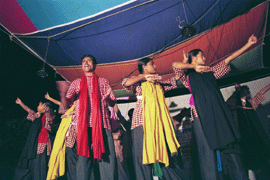
Actors in the play, "Environmental Thinking: Where will we go?" dance and wail to bring the message of climate change to hundreds of villagers in southwest Bangladesh. (Emilie Raguso)
CURWOOD: It’s Living on Earth. I’m Steve Curwood. The most populated nation directly in the crosshairs of global warming is Bangladesh. With tens of millions of people living at or just slightly above sea level, many of the citizens of this impoverished and overcrowded country could be forced to flee their homes before the century is out. International aid organizations and the Bangladeshi government are working to increase the ability of people to survive the rapidly changing environment. But it’s a tough race against time and tides.
Today we continue our series "Early Signs: Reports from a Warming Planet." The series is a collaboration of the UC-Berkeley Graduate School of Journalism, Salon dot com, and Living on Earth to document places around the world where concerns about climate change are already having an impact. Producers Sandhya Somashekhar and Emilie Raguso have today’s story from Bangladesh, which Ms. Somashekhar narrates.
[PEOPLE TALKING, KIDS TALKING, SOUND CHECK, BELLS, GENERATOR SOUND, DRUMS]
SOMASHEKHAR: It’s sunset in the jungle, and four musicians are tuning a drum and harmonium on stage.
[HARMONIUM SOUND, MORE SOUND CHECK]
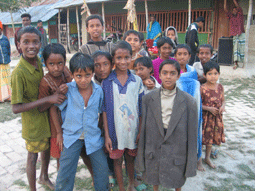
Local children were some of the first to check out what all the noise was about during the play's sound check. (Sandhya Somashekhar)
[BANGLA SONG]
SOMASHEKHAR: As the play opens, a dozen performers in red-and-white-checkered costumes act out a happy village scene. They collect lotus flowers and tend to their chickens and goats. Suddenly, a storm hits, flooding the entire village.
[STORM SOUND, MAN WEEPING, FLUTE]
SOMASHEKHAR: The play, called “Environmental Thinking: Where will we go?” is about the dangers of climate change. Floods, droughts, cyclones and saltwater pollution of farmland all appear in this show, just as they may someday in this very village.
MONDAL: To the village people, plays and dramas are a great source of entertainment and joy, because they don’t really have access to cinema. So whatever you say in a drama or a play, people remember it better.
SOMASHEKHAR: Mohon Kumar Mondal is an environmental activist with the local group Working for Coastal People. He helped to bring this play to southwest Bangladesh, where he grew up working the rice paddies with his father. Already, the ocean has begun to seep into the freshwater supply here. As a result, crops fail and people now walk miles for drinking water. So far, the main causes of this problem are massive dams built upriver in India and other man-made factors. But climate change will worsen the situation.
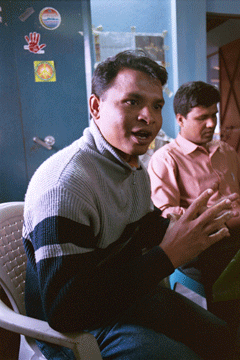
Mohon Kumar Mondal talks with CARE officials about climate change awareness programs in southwestern Bangladesh. (Emilie Raguso)
SOMASHEKHAR: Few doubt that global warming will bring disaster for Bangladesh, where 144 million people live in a space the size of Wisconsin. And the country is plagued year after year by natural disasters. Now comes climate change. Warmer temperatures will increase the intensity of cyclones that churn up over the Bay of Bengal and make the weather more unpredictable. Researchers have noticed that floods along the country’s three major rivers are happening more frequently, a trend that will worsen. But the most alarming effect of climate change is sea level rise. Within the next 100 years, the oceans could rise by a meter or more, inundating the coastal areas and devastating prime agricultural land.
HUQ: Firstly, it is a low-lying deltaic country, with large parts of the country just within one meter of the mean sea level. And if sea levels rise by a meter, that means that a large part of the country, something like 10 percent, will go under water.
SOMASHEKHAR: Saleemul Huq is a plant scientist and founder of the Bangladesh Center for Advanced Studies, the country’s top climate change research and policy organization. Some predictions say the land lost with a meter sea level rise could be almost twice as much.
HUQ: What makes Bangladesh distinct is the huge numbers of people that are at risk. If I take the coastal area, then with current populations there are about 20 million people living there. And over the next 50 years that size population is probably going to grow by at least another half. So the numbers of people that will probably have to be relocated, will have to move, will certainly have to change their livelihoods to survive, are in the tens of millions.
SOMASHEKHAR: Michael Oppenheimer, a professor of geosciences and International Affairs at Princeton, agrees.
OPPENHEIMER: If even a modest chunk of the Greenland Ice Sheet or the West Antarctic Ice Sheet goes, the sea level would rise past the capital of Dhaka, which is the center of the country. And untold tens of millions of people live between Dhaka and the sea right now.
[DHAKA CITY SOUNDS; TRAFFIC, CROWS, RICKSHAWS]
SOMASHEKHAR: Dhaka: one of the fastest growing cities in Asia. The air here is thick with diesel and the odor of open sewers, which hovers in a gritty cloud over the city’s unmapped tangle of roads and alleyways. Amid the clamor of trucks, two-wheelers and bicycle rickshaw bells, loudspeakers broadcast the Azan, or Muslim call to prayer.
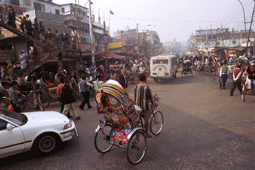
Dhaka, the capital of Bangladesh, is one of Asia's fastest growing cities. (Emilie Raguso)
SOMASHEKHAR: Every inch of this city is crammed with people, about 10 million of them. The Bangladeshi government here is well aware of the changes likely to be visited upon the country. There is a new climate change cell within the Department of Environment. And last year, with funding from the United Nations, it completed a National Adaptation Plan of Action, which proposed reforesting the coast, finding new sources of drinking water, and spreading awareness.
Massive international assistance will be necessary to weather this storm, says Mustafa Abu Kamaluddin, an environmental consultant working for the Bangladesh government.
KAMALUDDIN: Maybe it will be helpful and better adaptation if the international community that was responsible, they will come forward. If not then maybe some percentage of my people will die. Maybe they have to pay. I mean, we have overcome always, but we paid for that. Thousands of our people have been killed, but as a nation we survived.
SOMASHEKHAR: One of those people at risk is Ismail Hossain, a rural farmer living on the banks of the Kabadakshya River. He knows nothing about melting glaciers or carbon emissions, but he is intimately familiar with nature’s ferocity. Though his small village seems an oasis of palm trees and thatched huts, the river often spills over during the rainy season, flooding homes and turning emerald fields of rice into pools of mud.
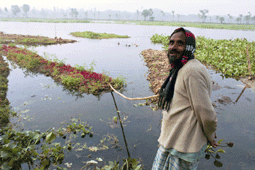
Ismail Hossain attends his floating gardens, built on bamboo and water hyacinth. The gardens give him more room to grow fresh crops, like red spinach and tomatoes. (Emilie Raguso)
HOSSAIN: At first I thought that the water will never go and that everything has been destroyed forever. Everything you are seeing was underwater. If I wanted to go anywhere else I had to call a boat and go everywhere through boats.
SOMASHEKHAR: The international aid agency CARE has been trying to teach people like Mr. Hossain to build stronger houses, carve moats around their homes and switch to salt-resistant crops, all in anticipation of climate change. He learned to build gardens that literally float on the water, an indigenous technique that he improved upon himself.
HOSSAIN: I first placed bamboos on the water and then pulled some of the water hyacinth on the bamboos. Then I collected the mud and put the seeds in the mud. Within four or five days, the seed came up and there was a beautiful tree coming out of the seed. Many people came here to see such an amazing thing.
SOMASHEKHAR: Mr. Hossain now has 13 vegetable gardens resting on the surface of the river, oblong beds overflowing with tomatoes and pale green bottle gourds. Still, he senses the worst is yet to come.
HOSSAIN: In the rainy season, the rain isn’t coming in due time, and in the winter it isn’t as cold as it used to be. I realize that the seasons are changing as the time goes on. I fear that something like this can happen in the future. But if such things happen and I can’t grow vegetables anymore, I will find a way to survive.
SOMASHEKHAR: Then he said something you often hear here.
HOSSAIN: When there is trouble, there is a way. (Laughs)
SOMASHEKHAR: People here can’t afford to be deterred by nature’s hardships. For example, there are people who live their entire lives on boats. Others – millions, in fact – live on sandbars that rise just a few inches from the surface of the sea. Land that could very well wash away during the next big cyclone.
But it is increasingly clear that Bangladeshi resourcefulness may not be enough to pull them through the coming changes. Eventually, many millions of people might have to flee the country, or die.
ULLAH: So, if it goes underwater, we have to move these people. Where do you move these people?
SOMASHEKHAR: Mahfuz Ullah is an environmentalist and journalist who has become something of a crusader for climate change awareness in Bangladesh. On a map of the country, he traces an arc across the jagged southern coastline – part beach, part wetland, part dense forest. That, he says, is the part of the country most likely to go under. It’s home to the Sundarbans National Forest, the world’s largest mangrove forest and the abode of the infamous man-eating Royal Bengal Tiger. It is also some of the continent’s most densely populated terrain.
ULLAH: If it comes to the question of relocating 100,000 people or even 50,000 people, it will be very difficult for the Bangladesh government to really relocate them.
SOMASHEKHAR: But others consider even that scenario far too rosy. Princeton’s Michael Oppenheimer talks of planning the evacuation of tens of millions of people.
OPPENHEIMER: In the long term the land is going, going, gone for a good chunk of the country. It seems to me that plans for the worst case need to be made. And that would mean a substantial withdrawal of a lot of the population.
SOMASHEKHAR: But no such plans are underway.
Ahsan Uddhin Ahmed is executive director of the food and policy research group, Bangladesh Unnayan Parishad. He says the Bangladesh government already has its hands full with today’s problems.
AHMED: With limited resources, our policymakers are not really prepared to spend money for something which will happen maybe 30, maybe 35 years later. They have immediate problems – you know, poverty reduction, educating all these people, providing primary healthcare services. So there comes a question how international community will come up and help our people, our government. If we leave the needs of adaptation onto the shoulder, or rather weak shoulder, of our government, then probably it will be another disaster.
SOMASHEKHAR: Until such assistance arrives, it will be up to the people to cope with changes that most will not understand.
[RADIO PROGRAM]
SOMASHEKHAR: Radio programs like this one, produced by CARE, are one way the message of climate change is reaching average Bangladeshis.
MONDAL: (in English) Black smoke.
SOMASHEKHAR: Mohon Kumar Mondal, the activist who helped bring the climate change play to the village, also uses a large flipchart with vivid illustrations of daily village life to spread the word.
[PAGES RUSTLING]
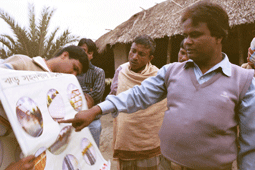
CARE created this flipchart, full of colorful images familiar to rural life, to help organizers teach villagers about the perils of climate change.
(Emilie Raguso)
SOMASHEKHAR: Most of these sources of emissions are luxuries Mr. Mondal’s audiences can’t even imagine. So he tries to use images that people recognize. One page of the flipchart shows a truck barreling along the road, a murky cloud escaping from the tailpipe. Behind are the tall smokestacks of brick kilns, a familiar presence on the landscape of southern Bangladesh.
[PAPER RUSTLING]
SOMASHEKHAR: Another shows cracked earth, made barren from saltwater pollution. Despite Mondal’s efforts, not everyone gets the message.
MONDAL: There are all sorts of reactions. First, a certain type of people say “Oh, scientists say a lot of things. And we have lived here for so many years and nothing has happened. Now something will happen in 30 years here? That can’t be.” That’s one type of opinion. Then, another group of people, those who believe in science, or those who are educated, they realize that we are witnessing things like sea level rise, the salinity. So they realize these things are true.
SOMASHEKHAR: When you ask people here about the coming changes they point out that they emit less than one percent of the world’s greenhouse gases, yet may well suffer the most in a warmer world. Journalist and environmentalist Mahfuz Ullah.
ULLAH: We are not responsible for climate change. We are not responsible for global warming. To what extent? We are paying for it. We will have to pay for it.
SOMASHEKHAR: If you ask if the country will be able to cope, people invariably point out that they already suffer every kind of natural disaster except volcanoes and they haven’t been wiped off the map yet. If you suggest that perhaps the government should consider an evacuation plan for the coast, they ask, then why not evacuate New Orleans? Mr. Ullah firmly believes in his country’s ability to adapt.
ULLAH: People of this country are resilient. At a personal level, I am an incurable optimist. And I know and have seen people, how do they cope with natural disaster. So, this is another natural disaster, for us. You know, this is a basic human instinct. We all want to survive. And this survival instinct will always keep people floating above the water.
SOMASHEKHAR: It would be foolish to underestimate Bangladeshi ingenuity, or the technological advances that could unfold in the coming years. But there is more than ever at stake for this drenched and downstream place, where so many people live at nature’s whim.
[MUSIC: Bangladeshi Street Music Troupe (anonymous)]
CURWOOD: Our story on Bangladesh was produced by Sandhya Somashekhar and Emilie Raguso as part of our series, “Early Signs: Reports from a Warming Planet.” “Early Signs” is a collaboration of the UC-Berkeley Graduate School of Journalism, Salon dot com, and Living on Earth. To read a print version of our story on Bangladesh and see photos of life in that delta nation, visit our website Living on Earth dot org. That’s Living on Earth dot O-R-G.
 |
 |  |  |
[MUSIC: Bangladeshi Street Music Troupe (anonymous)]
CURWOOD: We leave you this week with a visit to the next door neighbor of Bangladesh.
[CHANTING, BELLS RINGING]
CURWOOD: Hildegard Westerkamp recorded and mixed these sounds, chants and prayers from some of India’s most sacred places.
[EARTH EAR: “Attending To Sacred Matters” recorded by Hildegard Westerkamp from ‘Into India: A Composer’s Journey’ (Ear Say Productions – 2002)
CURWOOD: Living on Earth is produced by the World Media Foundation. Our crew includes Ashley Ahearn, Chris Ballman, Eileen Bolinsky, Jennifer Chu, Ingrid Lobet and Jeff Young - with help from Christopher Bolick, Kelley Cronin, and James Curwood. Our interns are Bobby Bascomb and Emily Taylor. Our technical director is Dennis Foley. Alison Dean composed our themes. You can find us at LOE dot org. I’m Steve Curwood. Thanks for listening.
ANNOUNCER: Funding for Living on Earth comes from the National Science Foundation, supporting coverage of emerging science; Kashi, maker of all natural cereals and snacks for health and wellness. Kashi. Seven whole grains on a mission; and Stonyfield Farm. Organic yogurt and smoothies and milk. Ten percent of profits are donated to efforts that help protect and restore the earth. Details at Stonyfield dot com. Support also comes from NPR member stations, the Ford Foundation, the Geraldine R. Dodge foundation and the Saunders Hotel Group of Boston's Lennox and Copley Square Hotels. Serving you and the environment while helping preserve the past and protect the future, 800-225-7676.
ANNOUNCER2: This is NPR, National Public Radio.
Living on Earth wants to hear from you!
Living on Earth
62 Calef Highway, Suite 212
Lee, NH 03861
Telephone: 617-287-4121
E-mail: comments@loe.org
Newsletter [Click here]
Donate to Living on Earth!
Living on Earth is an independent media program and relies entirely on contributions from listeners and institutions supporting public service. Please donate now to preserve an independent environmental voice.
NewsletterLiving on Earth offers a weekly delivery of the show's rundown to your mailbox. Sign up for our newsletter today!
 Sailors For The Sea: Be the change you want to sea.
Sailors For The Sea: Be the change you want to sea.
 The Grantham Foundation for the Protection of the Environment: Committed to protecting and improving the health of the global environment.
The Grantham Foundation for the Protection of the Environment: Committed to protecting and improving the health of the global environment.
 Contribute to Living on Earth and receive, as our gift to you, an archival print of one of Mark Seth Lender's extraordinary wildlife photographs. Follow the link to see Mark's current collection of photographs.
Contribute to Living on Earth and receive, as our gift to you, an archival print of one of Mark Seth Lender's extraordinary wildlife photographs. Follow the link to see Mark's current collection of photographs.
 Buy a signed copy of Mark Seth Lender's book Smeagull the Seagull & support Living on Earth
Buy a signed copy of Mark Seth Lender's book Smeagull the Seagull & support Living on Earth

